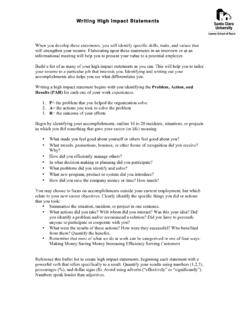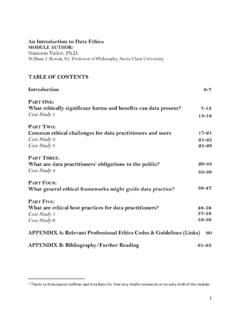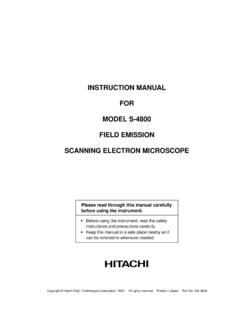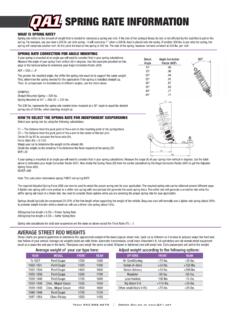Transcription of Introduction to Transportation Engineering
1 Introduction to Transportation Engineering Summer 2016 Transportation History 1794, First toll road, the Lancaster Turnpike, PA 1807, Fulton tested a steam boat on Hudson River 1869, First transcontinental railroad 1903, First flight of Wright brothers 1956, Interstate highway system began 1969, Men landed on the moon and returned 1972, BART completed 1992, ITS 1998, Electric cars Now high speed rail, driverless car, AHS, solar highway .. - 4,000,000 miles of paved roadway - 46,800 miles of interstate highways - 140,300 miles of freight railroads - 5,300 public use airports - 26,000 miles of navigable channels - 359,000 miles of oil and gas pipelines Each person in USA travels an average of 12,000 miles/year Our Transportation System Transportation is essential for a nation s development and growth USA GDP Source: DOT Transportation accounts for about 18% of household expenditure and employs over 10% of the workforce National Transportation Safety Statistics More than 40,000 deaths on the road per year ~ 1 death on the road every 12 minutes (40% DUI) ~ 1 injury every 11 seconds ~ 1 reported crash every 5 seconds ~ 4,000 fatalities in California Leading cause of death for people ages 1 to 33 (40%)
2 More Americans have been killed on highways than in all of the wars in which the nation has involved Traffic Congestion is a Headache - 30~40% of major urban highways are congested - Vehicle miles traveled increased by 39% from 1990 to 2013 - New road mileage increased by only 4% - The population grew by 27% - In 2013, traffic congestion costs Americans over $124 billion a year And, environmental and social impacts Land, energy and material consumptions The Transportation sector makes up 28% of total energy use Noise Disturbance to natural beauty Environmental changes Air and water pollutions ~ 70% of petroleum used in USA is for Transportation ~ 50% of CO emission and 30% of NO emission in USA come from highway vehicles ~ 20% of total US population is living in areas that do not meet the health-based standards Current Infrastructure Conditions and Travel Trends ~30% of America s major roads are in poor or mediocre condition.
3 Roadway conditions are a significant factor in approximately one-third of traffic fatalities 25% of America s 601,396 bridges are structurally deficient or functionally obsolete Americans rely almost exclusively on motor vehicles for mobility Travel in private vehicles accounts for ~90% of all person miles of travel Air travel accounts for ~8% Transit accounts for ~1% What can we do to improve Transportation safety and efficiency, and at the same time, reduce environmental and social impacts? Transportation Engineering - A Very Diverse Field The application of technology and scientific principles to the planning, functional design, operations and management of facilities for any modes of Transportation in order to provide safe, rapid, comfortable, convenient, economical, and environmentally compatible movement of people and goods Rehabilitation and reconstruction Remove or shield obstacles Add or improve medians Add lanes Widen lanes and shoulders Upgrade roads from two lanes to four lanes Improve road markings and traffic signals Highway Infrastructure Improvements One-way street Reversible street Ramp metering Signal coordination Parking restrictions Congestion pricing Traffic Control Improvements Telecommuting Short work week Variable work hours Carpooling Better transit system Travel Demand Management Satisfy present needs without compromising future generations needs Green vehicles Public Transportation Less car intensive lifestyle Walkability Bike lanes Sustainable Transportation ITS are the systems that utilize electronics.
4 Communications and information technology to improve the efficiency and safety of surface Transportation Intelligent Transportation Systems National 511 Service Public Traffic Sites En Route Driver Information En Route Driver Information En Route Transit Information Parking Systems Information Electronic Toll Collection Traffic Surveillance and Management Incident management Freeway ramp metering Signal control Traveler information Automatic vehicle identification Navigation Systems Dynamic Route Guidance Automatic Route Recalculation Crisp voice instructions Routing Options Detour and Avoid Roads Collision Avoidance Systems Issue warnings to the driver Modify the vehicle's operation as needed Make adjustment to safety devices such as airbags, seatbelts, suspensions, steering systems and brakes in anticipation of a collision Google Driverless Car Solar Roadways However, sometimes, Transportation people are not Designed by a Michigan California Version Hope it s not too Welcome to Decision Designed by a Minnesota Designed by another Minnesota Welcome to Cupertino, California Santa Clara, California I Want You In Transportation !
5 Questions?








